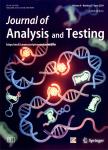Coordination Nanoparticles Formed by Fluorescent 2-Aminopurine and Au^(3+): Stability and Nanozyme Activities
作者机构:Department of ChemistryWaterloo Institute for NanotechnologyUniversity of WaterlooWaterlooON N2L 3G1Canada
出 版 物:《Journal of Analysis and Testing》 (分析检测(英文))
年 卷 期:2019年第3卷第3期
页 面:219-227页
核心收录:
学科分类:0830[工学-环境科学与工程(可授工学、理学、农学学位)] 081704[工学-应用化学] 07[理学] 0817[工学-化学工程与技术] 08[工学] 0804[工学-仪器科学与技术] 0805[工学-材料科学与工程(可授工学、理学学位)] 070303[理学-有机化学] 0703[理学-化学] 0702[理学-物理学]
主 题:Coordination nanoparticles Nucleotides Gold Nanozymes
摘 要:Nucleobase-metal coordination polymers(CPs)have been the target of much recent research owing their interesting properties and ease of *** nucleobases are nonfluorescent,and 2-aminopurine(2AP)is a strongly fluorescent analog of *** this work,we compared the CPs formed by adenine,2AP and adenosine with various *** Au3+produced CP nanoparticles with both adenine and *** products were similar in terms of size,suggesting that the position of the exocyclic amine is unimportant for coordination with *** 2AP is fluorescent,the dissolution of the nanoparticles in the presence of various chemicals including KCN,GSH,iodide,bromide and chloride,was studied and compared to fluorescent adenosine-Au *** appears that the 2AP CP was more robust than the adenosine one since even chloride can quench the fluorescence of the adenosine/Au ***,the adenine and 2AP nanoparticles exhibited weak oxidase-like activity for oxidation of TMB possibly by the Au3+exposed on the surface.



